A much greater number of people serve on juries than participate in the judicial system as plaintiffs, defendants, or attorneys. It is therefore vital that the jury assembly areas be as welcoming as possible. This blog addresses how an architect or courthouse planner can ensure that the jury assembly area provides the spaces needed to create a welcoming and user-friendly experience for prospective jurors during the court planning process.
Civic Duty Supported
Prior to being empaneled for a jury, potential jury members must check in and participate in orientation before beginning the process of jury selection, which usually takes place in a courtroom. To accommodate the jury orientation process, courthouses typically provide jury assembly areas dedicated to this purpose.
In some courts, prospective jurors may wait several hours prior to jury selection. In some instances, jurors not selected for a trial one day may be asked to return a second or third time. Thus, the jury assembly area should provide a comfortable and accommodating waiting space.
In small courthouses with limited space, the spectator seating area in a courtroom is often used for jury assembly. In some cases, a much smaller jury deliberation room may be used. Neither of these options provides user-friendly accommodations for prospective jurors. Courtrooms offer no support facilities and jury deliberation rooms are normally too small. In fact, after many years of inspecting courthouses, I have come to regard the jury assembly room as the courthouse’s “red-headed stepchild.” Granted, where this deficiency does occur, it is often not by choice. Significant space limitations often force a court to choose between a jury assembly room and a seemingly more critical space, such as a judge’s chambers or expansion of the clerk’s office.
However, when there is an opportunity to provide a more welcoming jury assembly area, what should this facility look like? Here are some of the best practices I have seen. In these examples, the courthouse planner has thoughtfully considered the jury assembly room as the prospective juror’s introduction to the judicial process and has provided a welcoming, comfortable space that honors their civic duty. A well-designed jury assembly area might include the components depicted in the following layout and further described below.
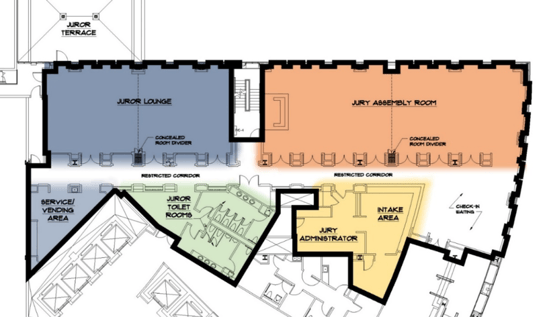
A Well-designed Jury Assembly Area
Key Components of Jury Assembly
Intake Area (yellow)
An administrative intake area located at the entrance to the jury assembly room allows court personnel to immediately assist prospective jurors as they enter. This sets the tone for creating a stress-free jury participation process.
Assembly Room (orange)
A spacious and well-organized assembly room, such as the one depicted below, helps orient jurors so they understand what to expect as they serve this important duty. It should be comfortable and free from distractions to allow prospective jurors to focus on the jury selection process. A clear understanding of what to expect can be a great stress reliever.
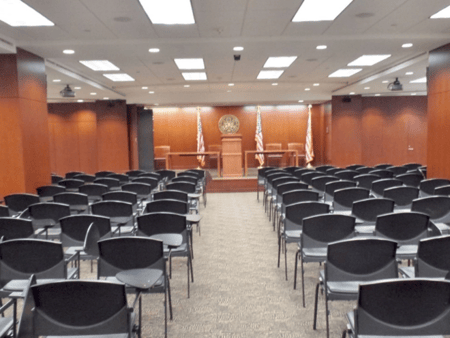
Assembly Room
Jurors’ Lounge (dark blue)
Since prospective jurors may have extended wait periods between check-in and assignment for jury duty, comfortable seating is important. Magazines and televisions should be provided to accommodate jurors during long waiting periods.
The following photo is an example of a comfortable, well-furnished lounge that also has a spectacular view of the surrounding cityscape. The room is a focal point of the courthouse and is also used for court-sponsored civic events.
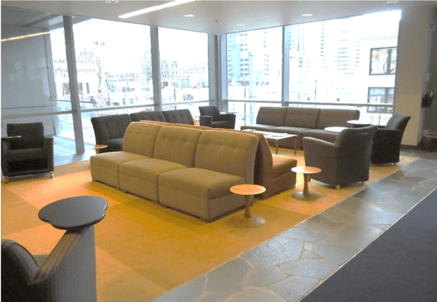
Jurors’ Lounge
Restrooms and Vending Areas (light blue and green)
Restrooms and a vending area should be provided within the jury assembly area for the prospective jurors’ convenience and to ensure a smooth and efficient jury assembly process.
Bonus Spaces for Jury Assembly
Jurors’ Storage Facilities
Since jurors are normally unable to take personal items with them into the courtroom, they may be required to leave them behind. For this reason, providing secured storage facilities for personal items in the jury assembly area can be very helpful to jurors.
Computer Access Area
Laptops and other mobile devices are the norm today. Many people have to take time away from work to serve on jury duty, and almost everyone has some kind of mobile device to stay connected throughout the day. Rather than asking prospective jurors to balance laptops on, well, their laps, it is ideal to provide a space designated for this purpose. The computer access area depicted in the photo below provides a convenient space for prospective jurors to catch up on business, surf the Internet, or charge their devices while waiting to begin the jury selection process.
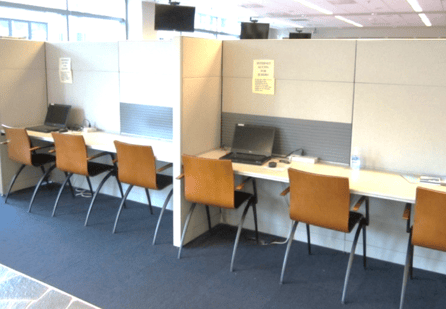
Computer Access Area
A Civic Duty Not Supported
In her article, Are Your Jury Facilities Guilty of Neglect?, Alison Jones, a courthouse planner and colleague of mine, describes her personal experience as a prospective juror. She observed: “My assembly room had none of the above. Magazines would have been a dream! The orientation room was rather small and crowded, with a U-shaped table and chairs lined up against the wall and inside the U – certainly not the most welcoming setting for jurors. I had to squeeze by several people to find a seat along the wall. Restrooms were all the way down the hallway and no water was available. It wasn’t terrible, but…”
Alison’s jury experience clearly left a lot to be desired. “It wasn’t terrible” is not the impression courthouse planners should be going for when designing jury assembly spaces. The conditions she encountered hardly honor or support the civic duty she and the other jurors performed. Let’s aim to make jury assembly spaces way more than “not terrible” – let’s aim to make them “very efficient and welcoming!”



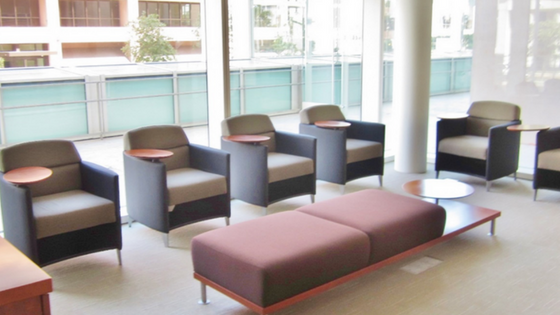
.jpg)
.jpg)
.jpg)
.jpg)
.jpg)
.jpg)


-1.jpg)
.jpg)
.jpg)

